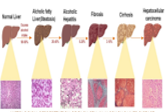Abstract
An Alcoholic Liver Disease (ALD) has emerged as the serious health problem globally, with high morbidity and mortality rate. Heavy alcohol consumption resulted in broad spectrum of liver diseases ranging from steatosis (alcoholic fatty liver), alcoholic hepatitis (AH), fibrosis, cirrhosis, and hepatocellular carcinoma (HCC). In this review the detailed patho-physiology of the ALD, role of oxidative stress ALD, the mechanism of action of flavonoids with different models used have been explained. Heavy alcohol consumption leads to severe liver diseases, which is demonstrated by increased blood levels of ALT, AST, and/or lactate dehydrogenase (LDH) and accumulation of lipid in the hepatocytes causing steatosis. There are three mechanisms involved in causing of ALD, those are: (a) acetaldehyde toxicity; (b) oxidative stress or generation of ROS; and lastly (c) provocation of the immune response of hepatocytes causing oxidative stress. This shows that oxidative stress is a major cause for ALD, therefore, defence activities against this stress are most vital in the prevention of ALD. Application of antioxidants especially flavonoids signifies a rational curative strategy to prevent and cure liver diseases involving oxidative stress. Flavonoids inhibit ROS formation by regulating glutathione S-transferase, mitochondrial succinoxidase etc. Since lipid peroxidation is a result of oxidative stress, lipids are protected from oxidative damage using flavonoids. Various flavonoids and their mechanism of action have been discussed in this review, formulation of these flavonoids will be highly beneficial for treatment of ALD.
Full text article
Authors

This work is licensed under a Creative Commons Attribution-NonCommercial-NoDerivatives 4.0 International License.

